Prior post: http://blog.bucksvsbytes.com/2019/12/10/south-america-by-subaru-19-11-03-more-meat/
[NOTE: To enlarge any image, right click it and choose “Open image in New Tab” or similar.
We pack up, say our goodbyes to Janina and Chris’s family, and head north.
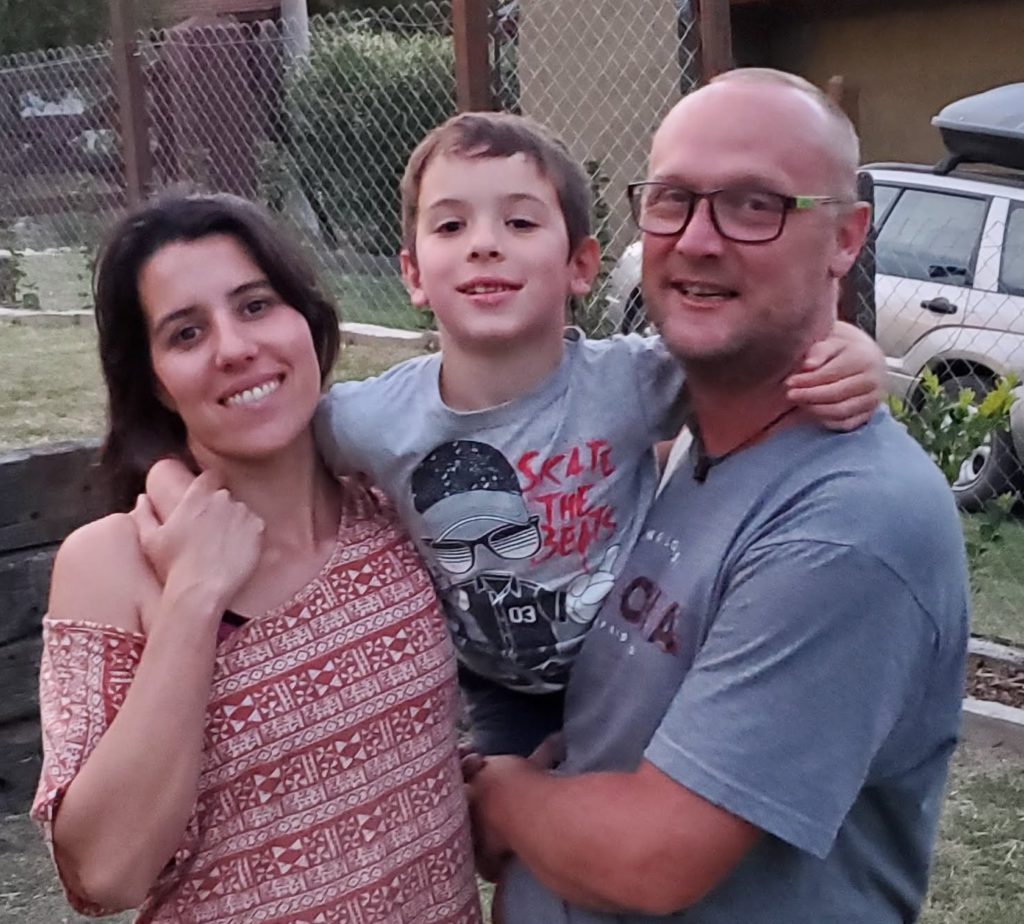
To explain what we’re doing, I need to provide a flashback here: Last November, on our way to Bolivia, we had discovered Calilegua National Park in northern Argentina. It’s a large, remote preserve containing one of the southernmost portions of South American jungle, which extends, despite vast areas that have been cleared for farming, in one form or another at least 1200 miles below the Equator. The ecosystem here, while not full tropical jungle, is very lush and in the areas where preserves have been established there’s still potential for seeing exotic wildlife. Google Maps had shown a route through that park that connected back to our highway to Bolivia. It looked satisfyingly primitive and had an equally satisfyingly enormous number of squiggles, which generally means mountains with switchbacks and grand views. We went out of our way to traverse this route from east to west. As we entered the park, though, a very friendly indigenous ranger made it clear to me that the road we were on was a dead end, since several miles in the middle were a foot trail rather than a road. This Google data failure was quite a disappointment, but we had a wonderful day driving into and beyond the national park. Although we saw no wildlife, being in the jungle for the first time since Iguassu Falls in December 2017 was a great experience, and the road was just as challenging and dramatic as we had hoped. We were still many miles from the dead end when it started to rain. The road, in a flat valley by then, got muddy and slippery so we decided discretion was the better part of valor, turned around prematurely, and backtracked to the main highway.
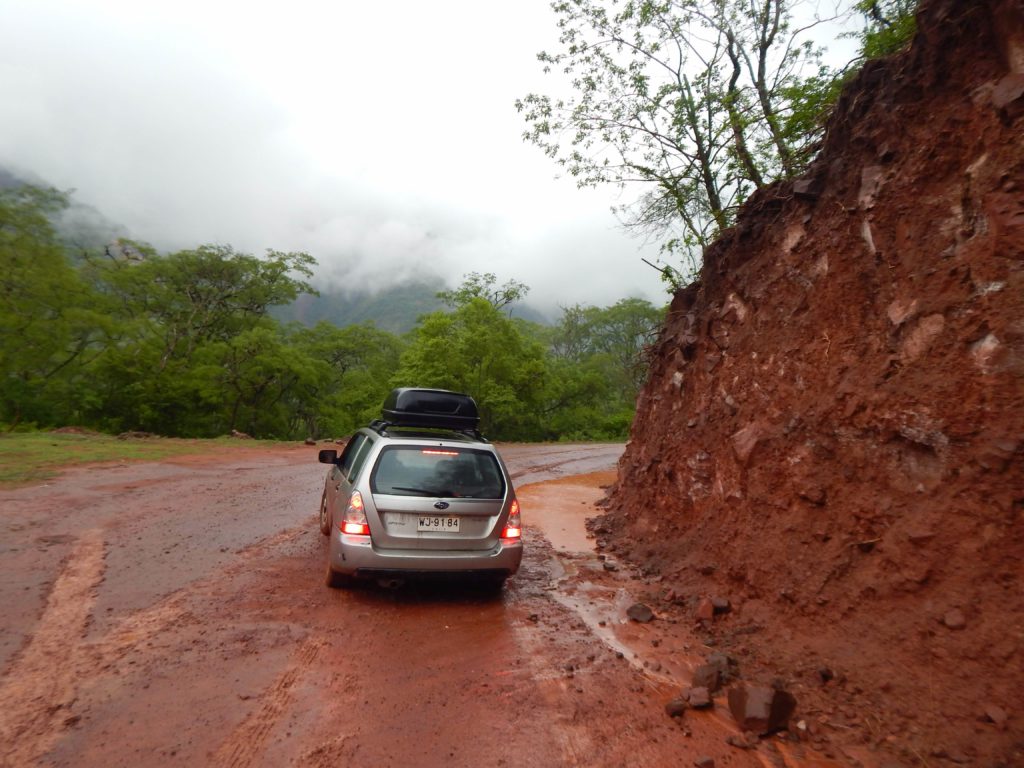
Flash forward, briefly, to Livingston Manor in August, 2019. We host Servas Israel visitors Tamar and Giora for a few days. In the course of our conversations, it comes out they had also driven this remote road, which we all decide is a very unlikely coincidence. In a follow up, they have recently sent us a link saying the missing piece of road on the Calilegua route has been built. I do further research and find a newspaper article celebrating the grand opening of the connection just 5 weeks ago and touting how the new through route will make the area an Argentine version of the Cusco region in Perú.
Waiting a week to meet Jaqui becomes the rationalization for making a northern loop to obsessively complete our aborted crossing — and it’s no small loop. This side trip will entail over 1,500 miles of additional driving, including at least 140 miles of rough road. Yes, I know – we’re nuts, but at least Susan and I are both all in on the idea.
As we leave Santa Rosa, we pass a large banner advertising the Fiesta de Tradiciones, a celebration of gaucho (Argentine cowboy) culture. Susan loves both horses and gauchos (who have strong indigenous origins) but it’s pretty obvious that our commitment to meet Jaqui and go to Buenos Aires with her precludes coming back to Santa Rosa for the festival. We head north, pushing a little harder than normal because of our time constraints.
In the small town of Bialet Massé, we parallel a light rail train, one of the few passenger routes left of Argentina’s once extensive network. It probably serves as commuter rail, feeding workers from Cosquín south into the city of Córdoba. In Argentina, where most railroads are just derelict rights of way, seeing an operating passenger train counts as exciting.

The countryside along our route is pretty flat and uninteresting at first, but I’ve discovered a “longcut” (opposite of “shortcut”) through a mountain range that the main route skirts by going around it. As usual, this is a gravel road that winds up through remote ranch country.

At the highest point, we find an unusual amenity, a shaded overlook with long views and benches. Named Mirador de Cerro Alfa (Overlook from Alpha Peak), it becomes our lunch spot. While we’re eating, two Mexican bicyclists come struggling (at least in my eyes) up the mountain in the opposite direction and take a break. We have a short conversation about safety for car driving tourists in Mexico before they start their downhill ride to the south.
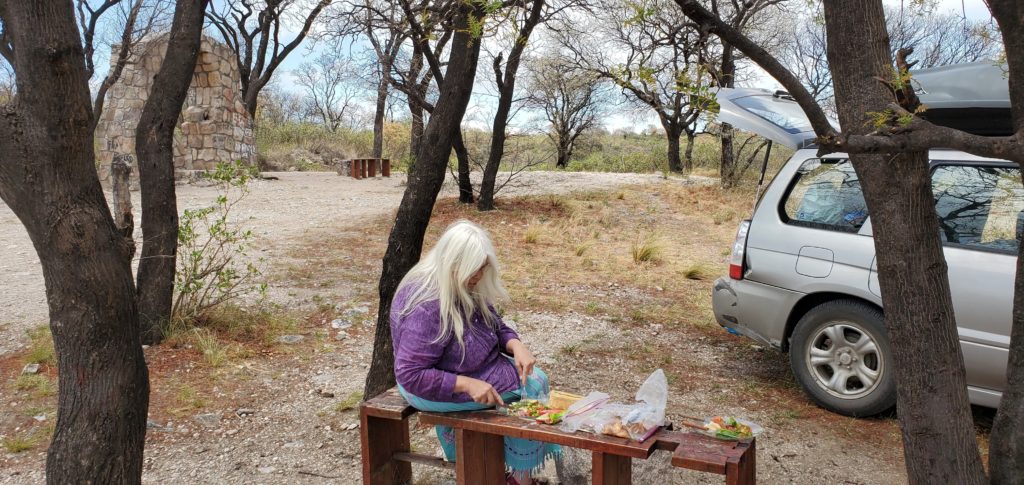
We pack up and begin the harrowing but well engineered descent, thoroughly satisfied with our choice of detour. Still in the middle of nowhere, we come across an incongruous, faded sign advertising the “Hippie Museum”.
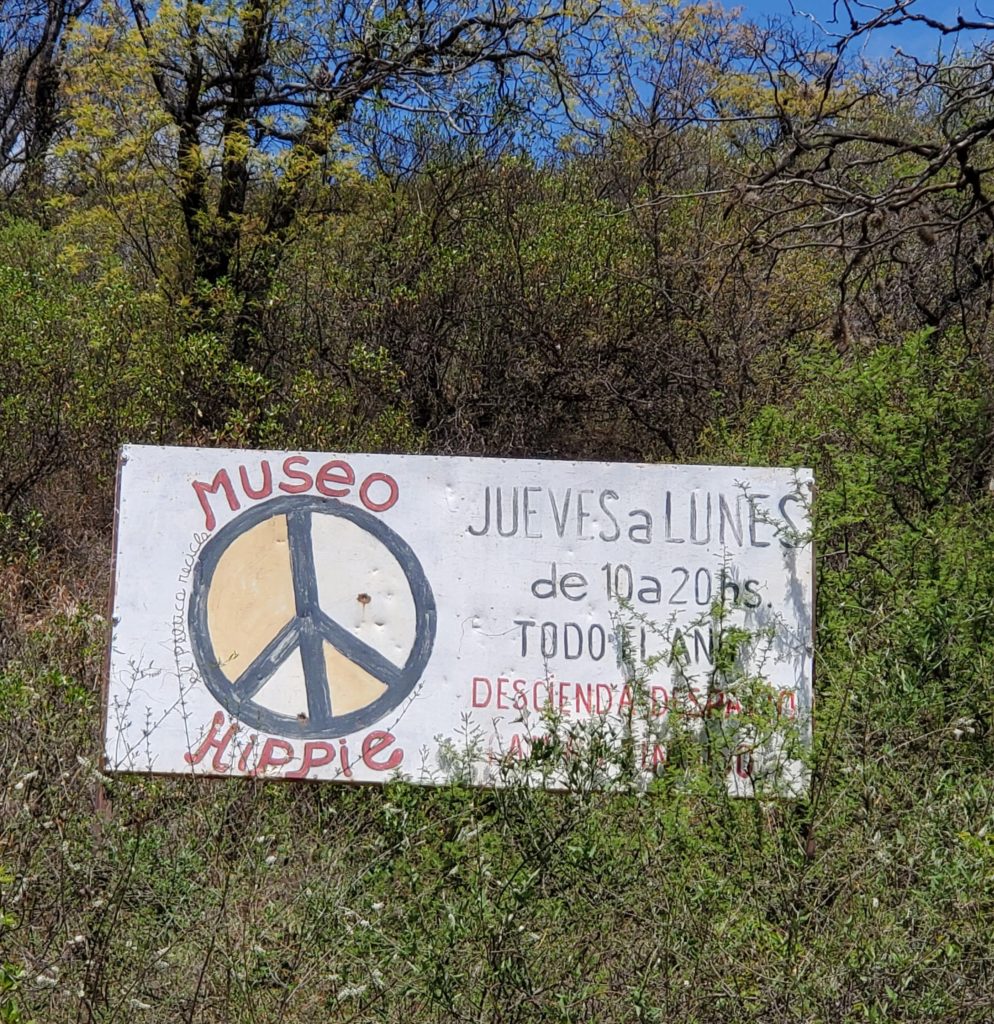
Apparently, this road was somehow on the “Gringo Trail” decades ago. When we reach San Marcos Sierras back on the flats, we decide to pass on the famous museum (if it even still exists), but we notice some classic cars parked around town, an old Desoto and a Ford Falcon station wagon.

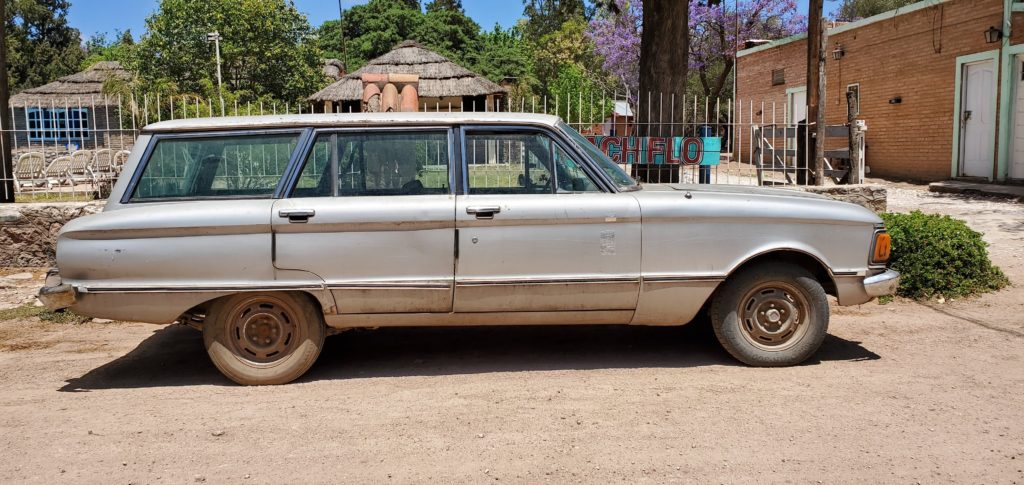
Driving across the pampa, we work our way back to the main highway and continue north at high speed. Alberto warned us that Córdoba province has started using radar speed control and, sure enough, in the middle of nowhere a police car is parked on the shoulder and, standing in the shade, is an officer with a clunky, tripod mounted radar dish clocking vehicles entering Córdoba from Santiago del Estero. Little by little, Argentina is adopting the U.S. model of trap, cite, and penalize.
We’re heading into an expanse of salt flats to cross what Google Maps shows as a large, inland lake. The land is quite flat, with sparse cattle grazing both sides. We start seeing crusts of salt on the ground but when we reach the depicted causeway, the “lake”, at least at this time of year, is indistinguishable from the “shore”. Salt is plentiful, however, as we pass side roads with signs announcing salt processing operations.
We start noticing that every time the air conditioner is running, there is a squealing sound from under the hood — a strong indicator that a drive belt needs tightening. As the hours pass, we realize that our day will end in San Miguel de Tucumán, the only city for many miles. We pull over to start looking online for suitable accommodations. We happen to be at a truck stop with a repair shop, so I go in to ask if they will tighten the belt for me. A couple of young men tackle the task and, once the engine cools down a bit, they access the fairly inaccessible adjusting bolt and stop the squeal. They want to charge me less than two dollars for about 30 minutes work but I press double that on them, thanking them for their fast service and for burning their hands slightly.
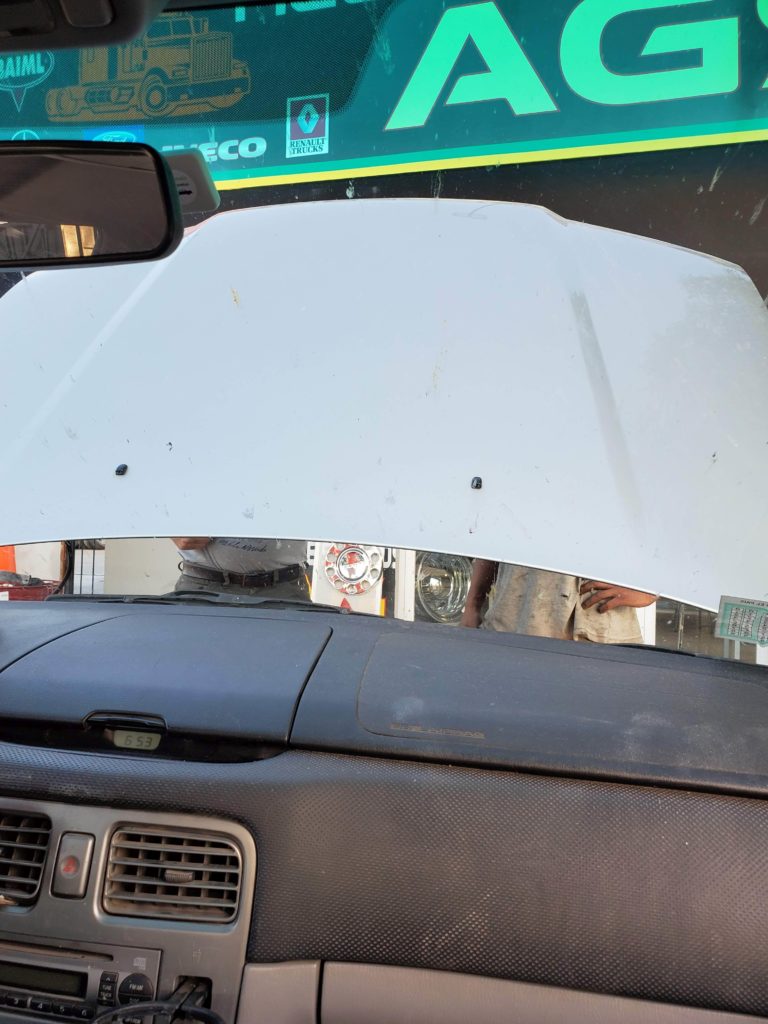
The first lodging we check out is primarily an event space and say their few rooms are all occupied. Our cell service, as is frequently the case in Argentina, is close to useless so we head into town for a gas station to get wifi and choose a second option, La Providencia. It’s completely dark when we have one. Finding lodging after dark is our worst case scenario as it makes the task much harder. We follow Google directions about 15 minutes to a quiet residential neighborhood. When we reach the apparent building, there’s no sign that it’s a hostal. I ring a bell at the driveway gate and a very cautious and suspicious woman tells me she’s never heard of La Providencia.
We have no option but to backtrack to the gas station so I can make one of my rare phone calls to talk to the hostal. I have no problem speaking Spanish (which is not to say others don’t have problems understanding me), but my aural comprehension is still pretty bad and it’s much worse on the phone. Fortunately, the woman who answers is pretty understandable and she assures us that she has room and that we were on the right block. We drive back out and, directly across the street from our earlier inquiry, she’s standing outside watching for us.
Silvia welcomes us, guides the car into her narrow driveway, and insists on helping us drag our luggage through the front door. Right over the door is a small lighted sign “La Providencia”, which we had missed on our earlier foray in the dark because we were focused on the other side of the street where Google Maps had pointed us.
Silvia’s little B&B is charming and spotless. As if the name wasn’t enough of a clue, the walls are sprinkled with several indicators of devout religious belief. She shows us to a very nice room, takes us into the kitchen and feeds us a hefty evening snack of bread, cheese, and avocado. We have a nice conversation and for Susan’s benefit, she sprinkles as much English into it as she can. Eventually, we go up to bed and lapse quickly into unconsciousness.







